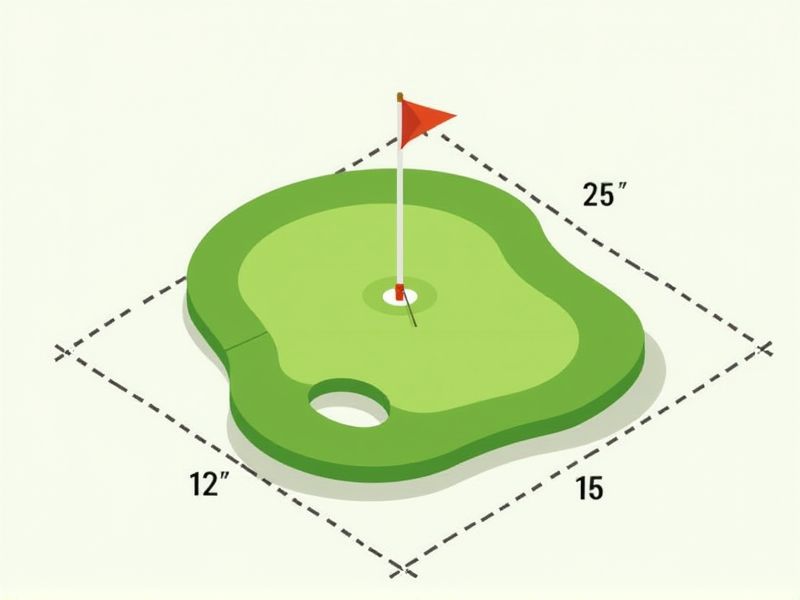
The standard dimensions of a golf hole are carefully regulated to ensure consistency across courses. According to the Rules of Golf, the hole should have a diameter of 4.25 inches (108 millimeters) and a minimum depth of 4 inches (101.6 millimeters). These precise measurements help maintain a fair playing field for all golfers, regardless of skill level. Knowing these dimensions can be especially useful if you're setting up a practice green at home or checking course compliance.
Hole Length
A standard golf hole typically ranges from 100 to 650 yards in length, depending on its classification as a par 3, par 4, or par 5. Par 3 holes generally measure between 100 and 210 yards, emphasizing precision and skill in short-distance shots. In contrast, par 4 holes usually extend from 250 to 450 yards, requiring a combination of distance and accuracy from players. For par 5 holes, lengths can exceed 450 yards, often inviting strategic play and the opportunity for players to reach the green in two strokes.
Par Rating
The standard golf hole typically has a par rating that ranges from 3 to 5, with par 4 being the most common. Each par rating determines the number of strokes an expert golfer is expected to take to complete the hole, influencing course difficulty and strategy. For instance, a par 3 hole usually measures between 100 and 250 yards, requiring precision over distance. Understanding the par rating is crucial for planning your shots and improving your overall game.
Diameter Of Hole
The standard diameter of a golf hole is 4.25 inches (10.8 cm), a specification established by the United States Golf Association (USGA) and the Royal and Ancient Golf Club of St Andrews in the 19th century. This size has been maintained to ensure uniformity across courses, making it easier for players to gauge putting distances and hole locations. When you aim for a success rate in sinking putts, understanding the dimensions of the hole can enhance your strategizing on the green. Adhering to this standard promotes consistency in scoring and enhances the overall golfing experience.
Cup Depth
The standard golf hole measures 4.25 inches in diameter and must have a depth of at least 4 inches, with many courses opting for a depth of 4.5 inches for better playability. This depth allows for a proper fit of the flagstick and offers a margin for more forgiving putts, as a shallower hole could lead to increased difficulty. The cup's positioning on the green can significantly influence play, as sloping surfaces and strategic placement can affect putt direction and speed. Ensuring the hole is cut cleanly and maintained regularly enhances both the aesthetics and challenge of your golfing experience.
Tee Box Size
The standard golf tee box size for each hole typically measures 5 feet by 2 feet. This designated area accommodates various tee placements, allowing players to choose the most suitable height and position for their shots. Depending on the course, you may find multiple tee boxes, often identified by color codes to indicate difficulty levels, with the longest tees situated farthest from the hole. Maintaining the tee box's integrity through proper care ensures a consistent and enjoyable experience for you and all golfers.
Fairway Width
The standard fairway width for a golf hole typically ranges from 25 to 40 yards, providing ample space for golfers to aim for optimal shots. Factors such as course design, terrain, and intended difficulty level influence these dimensions. Narrower fairways, often around 25 yards, challenge players to improve their accuracy, while wider options can enhance playability and enjoyment. A well-maintained fairway not only promotes better ball conditions but also significantly impacts a golfer's overall performance and strategy on the course.
Green Dimensions
The standard dimensions of a golf green typically measure between 5,000 to 7,500 square feet, but this can vary based on the course's layout and design. Greens are usually shaped in a circular or oval form, with an average diameter ranging from 12 to 18 yards. The surface of the green is meticulously maintained to achieve a grass height of 0.125 to 0.25 inches, ensuring optimal putting conditions. Understanding these dimensions can significantly impact your approach to the game, as they influence the speed and break of putts.
Bunker Placement
Bunker placement is crucial in the design of a golf hole, as it significantly affects strategy and playability. Positioned strategically around the green and fairway, bunkers can challenge players by creating hazards that demand precision and skill. For example, a well-placed bunker 150 yards from the tee can alter your approach shot, pushing you to take risks or choose a safer line. Understanding how bunkers interact with both the wind and the terrain allows you to make informed decisions on club selection and shot execution.
Rough Width
The standard rough width for a golf hole typically ranges from 12 to 24 inches, significantly impacting playability and challenging golfers' skills. Maintaining this rough helps control ball trajectories and encourages precision in shot placement. The width of the rough also varies based on course conditions, seasonal weather changes, and maintenance practices, often requiring adjustment based on player feedback and performance. You can enhance your game by practicing shots from various rough widths, developing a better understanding of ball control and the effects of grass type on your swings.
Water Hazard Proximity
A standard golf hole typically measures between 350 to 450 yards, integrating water hazards that are strategically placed within 100 yards of the green. Such water features not only enhance the aesthetic appeal but also significantly influence shot strategy, requiring golfers to assess risk versus reward. The proximity of water hazards often dictates the club selection, with players needing to weigh their chances of clearing the hazard against potential penalties. Understanding the layout and planning your shot based on water hazard locations can be crucial for achieving a lower score.
